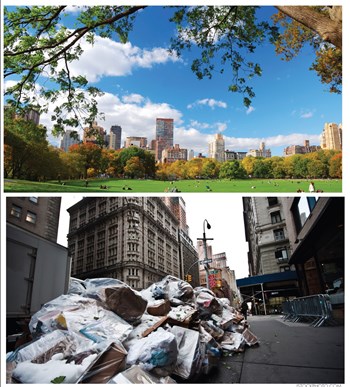
The city that never sleeps: That’s New York, and it turns out it’s one of the things that its residents adore most about it. It’s also one of the things they hate. Along with the convenience, access and availability to just about everything at any time comes the noise, dirt and overcrowding that is the other face of New York City.
Without question the city is unique – Unique New York, as the tongue twister says. (Say it three times fast!) New York offers opportunities not found anywhere else. Along with the chance to become whatever you aspire to be, you also have the opportunity to do it while living in a tiny room in a shared apartment for more money than your parents pay for their mortgage on their four-bedroom colonial in the town or suburb you grew up in. Yet, every day you can look up at the penthouse in that new building not far from where you stumble up the stairs to your fifth-floor walk-up apartment and dream that someday it could be yours.
What makes New York so unique? It has everything. If you aspire to the arts, here is where the mentors and the critics are. If you want to be a captain of industry, here is where the generals and admirals of the world’s most powerful economic forces plot their strategies. If you want to make a name for yourself in the world of law or government, here is where the most high profile offices of those professions, both public and private, hang out their shingles. It’s a never-ending list.
For all of that, however, the one thing that most New Yorkers share is a love/hate relationship with the city they call home. It’s stiflingly hot in the summer, and bitterly cold in the winter. It’s profoundly seductive, but insultingly expensive. It’s convenient, but crowded to the point of frustration. It’s the fastest place in the world, with crosstown traffic that often moves just a few feet at a time. You might love the luxury of a taxi or Uber, but the subway will always get you there faster and a lot cheaper...unless your line is under ‘regularly scheduled necessary maintenance,’ which any New Yorker will tell you is really a euphemism for ‘the system breaks down a lot.’ New York is both enchanting and aggravating—and The Cooperator reached out to some professionals in the multifamily real estate industry to tell us about their own love/hate relationship with their City.
Convenience
It seems the single thing most residents love the most is the convenience that city life affords them, especially in Manhattan. “Everything is within your grasp,” says Dorothy Somekh, an associate broker with Halstead Properties, a large real estate brokerage firm with locations throughout New York City. “Shops, restaurants – whatever you need. And you can have anything delivered.”
Julie Schechter, a co-op and condo attorney with Montgomery McCracken Walker & Rhoads LLP, a law firm located in midtown Manhattan, has lived in the New York area all her life and in Manhattan for the past eight years. She lived in Brooklyn before that. “You can walk to work,” she says of the extreme level of convenience the city offers. “And you can have anything you want delivered any time of the day or night. I love the fact that I don’t need a car.”
“The convenience of everything,” echoes Jason Cohen, a partner in a Flatiron District real estate firm. A lifelong New Yorker, he was raised on the Upper West Side and now lives in a co-op building in Greenwich Village. “You can get an egg roll delivered at 2 a.m., if you want. “
The Best of Everything
Access to the best versions of just about everything is another oft-cited reason why New Yorkers love New York. “Museums, theater, and the best medical facilities in the world,” are here, says Ken Graff, a board member of a co-op located in Riverdale, directly north of Manhattan. “Think about the major hospitals located here.”
“Museums and cultural institutions like Lincoln Center,” says Larry Lubin, a broker with Klara Madlin Real Estate.
“New York is exciting, vibrant. Like being on vacation all the time,” adds Somekh. “It’s fun to live here.”
Terry Tener, a principle at KTR Real Estate Advisors, a Manhattan-based valuation firm, adds an interesting twist. “Diversity appeals to me,” he says, “amenities that include art museums, Broadway theatre, and all the things that the city offers beyond working and sleeping.”
Cohen suggests another great aspect of city life. “It’s a great place to raise children, because of the diverse environment. My kids developed a strong ‘street sense’ they wouldn’t have anywhere else.”
And perhaps the thing all of the above loved most about their city is the people. One real estate pro remarks that New Yorkers’ reputation for being rude is both largely overstated and fundamentally inaccurate. “We’re just busy,” she says. “Compared to people in smaller, slower-paced places, I guess we might seem brusque or aggressive, but that’s just because we’re always on the way somewhere and don’t have time for a lot of chitchat. We’re happy to give you directions, or help you get your baby carriage up or down the subway station stairs – just don’t stop dead in the middle of the sidewalk to answer a text on your phone, then get all miffed when I shoulder-check you to avoid winding up in a tree-pit.”
On the Flip Side
If fellow New Yorkers are one of city-dwellers’ favorite aspects of their home, they’re also one of the biggest pet peeves. Crowds, traffic, and the hassle that even simple tasks can turn into all help balance out the glories and delights of Gotham.
“It’s too crowded and the traffic is terrible,” says Cohen. “It doesn’t matter what time of the day or night it is, the streets are choked with cars. There are too many tourists.”
Somekh feels the same way. “Traffic, especially parking, is always a problem,” she agrees. “And everyone is rushing around all the time. The pace is too hectic. And it’s expensive.”
The cost of living ranked high on most other ‘worst of’ lists as well. Schechter, the attorney, says that though she loves living here and she loves her apartment, “It’s small, and expensive. I would like more closet space.” It can also be a little noisy. “I hear my neighbors all the time,” she says. “You wouldn’t hear them in a house in the suburbs.”
There seems to be a particular ire for the subway, the thing all New Yorkers love to hate. Crowded, dirty, slow and often with serious service delays, all those interviewed indicated that it was at the top of the list of things that need improvement, an interesting fact in light of recent fare increases. The price goes up with dismaying regularity – yet the conditions remain the same, or get worse.
Traffic is another sore spot. Not only is it slow and ponderous on city streets, but access to destinations outside the city can be difficult as well. “The inability to get to an airport quickly really bothers me,” says Graff, the co-op owner from Riverdale. Unlike many other major metropolises, New York has not yet devised an efficient public transportation plan to move travelers to and from the area’s three airports. From midtown Manhattan, it can take up to two hours to reach Kennedy Airport in Queens, the city’s major international air portal. Graff reports that “even with set-price fares from the airport, a recent taxi trip home from JFK cost $100.”
Tener, who has followed the development and evolution of New York City closely over the past 40 years, suggests one other interesting slant on the issues that dim New York’s luster. “The inane politics that play havoc on the community,” he says. “It has caused a lack of availability of good education for our residents, which is a disappointment and it affects our future negatively.”
In the end, though, despite the gawking tourists, the screeching subway rails, and the sky-high daily expenses, New Yorkers maintain a fierce love and loyalty for their city. They stay for all the reasons mentioned above, and more. Perhaps Tener says it best, with the observation that “New York is not a place to sleep, it’s a place to live.”
A.J. Sidransky is a published novelist and staff writer for The Cooperator.






Leave a Comment